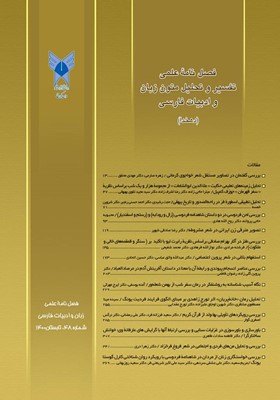تحلیل تطبیقی اسطورۀ فرّ در راحهالصّدورو تاریخ بیهقی
محورهای موضوعی : متون زبان و ادبیات فارسیحجت رشیدی 1 , احمد حسنی رنجبر 2 * , شروین خمسه 3
1 - دانشجوی دکتری گروه زبان و ادبیات فارسی، واحد تهران مرکزی، دانشگاه آزاد اسلامی، تهران، ایران.
2 - استاد گروه زبان و ادبیات فارسی، واحد تهران مرکزی، دانشگاه آزاد اسلامی، تهران، ایران.
3 - استادیار گروه زبان و ادبیات فارسی، واحد تهران مرکزی، دانشگاه آزاد اسلامی، تهران، ایران.
کلید واژه: بیهقی, تاریخ بیهقی, راوندی, فرّه ایزدی, راحهالصدور و آیهالسرور,
چکیده مقاله :
راحهالصّدور و آیهالسّرور (تألیف حدود 603 قمری)، کتابی تاریخی از محمدبن علی بن سلیمان راوندی است در تاریخ آل سلجوق. این کتاب علاوه بر فواید تاریخی، از باب سلاست انشا و اشتمال بر اطلاعات فراوان اجتماعی در شمار معتبرترین و سودمندترین کتابهای فارسی پیش از حملۀ مغول است. میتوان موضوع فرّ در این اثر را با آثار دیگر زبان فارسی مقایسه و تطبیق داد. یکی دیگر از آثار معروف زبان فارسی، تاریخ بیهقی اثر ابوالفضل بیهقی است که کتابی تاریخی - ادبی بوده، و موضوع اصلی آن تاریخ سلطنت مسعودِ اول پسر محمود غزنوی است. از این رو میتوان موضوع فرّ را در تطبیق دو اثرِ مورد نظر جست. این موضوع در دو اثر جلوۀ خاصی دارد. مهمترین پرسش مطرح در این جستار این است که نگاه دو نویسنده به اسطورۀ فرّ چگونه است؟ بدین نتایج رسیدهایم که هر چند در راحهالصدور و تاریخ بیهقی موضوع اسطورۀ فرّ قابل مشاهده و ردیابی است، اما نگاه نویسندگان آن دو به این موضوع در مصادیق و مفاهیم متفاوت است. اسطورۀ فرّ در راحهالصدور در قالب خویشکاری، نمودهای بصری، تأیید الهی و تصریح به واژۀ فرّ ارائه شده است و در تاریخ بیهقی بیشتر در قالب و پوشش تقدیرگرایی، نمود آیینهایی چون جشن مهرگان، قدرت شیرگیری مسعود و....این تحقیق به شیوۀ تحلیل محتوایی و با استفاده از منابع کتابخانهای انجام گرفته است.
Rahat-Al-Sodour and Ayat-Al-Sorour (603Ah.) is a historic book by Mohammad-Ibn-Ali-Ibn-Soleiman Raavandi in Seljuk dynasty. In addition to its historic advantages, from its perspicuity of composition and intricacy of the abundant social information, this book is considered as one of the most authentic and beneficial Persian books before the Mongol attack. The topic of charisma could be compared in this work with the other Persian-language works. One of the other famous Persian-language works is Beihaghi’s History, which had been authorized by Abolfazl Beihaghi, as a historic-literary book, and its main topic is the history of the first Masoud monarchy as the son of Mahmoud Ghaznavi. Therefore, charisma topic could be investigated in comparing these two given works. This topic has a particular glitter in both works. The most significant question mentioned in this query is that how are both authors’ viewpoints to the charismatic myth? It is concluded that although in Rahat-Al-Sodour and Beihaghi’sHistory, the topic of charismatic myth is obvious and traceable, their both viewpoints to this topic is different in concepts and application. The charismatic myth in Rahat-Al-Sodouris presented in the form of function, visual manifestation, celestial endorsement, and stipulation to the charismatic lexicon and in Beihaghi’s History is more conducted in the form and vesture of celestial fatalism, some ceremonial manifestation such as Mehregan festival, the power of hunting the Lion by Masoud, and etc. This research is conducted by the content analysis and using the library-based sources.
کتابها
بیهقی، ابوالفضل (1389)تاریخ بیهقی، سه جلدی، به کوشش خلیل خطیب رهبر، تهران: مهتاب.
راوندی، محمدبن علی بن سلیمان( 1386)راحه الصّدور و آیه السّرور، تصحیح محمد اقبال، تهران: اساطیر.
رجایی، فرهنگ(1375)تحول اندیشۀ سیاسی در شرق باستان، تهران: قومس.
سودآور، ابوالعلا( 1383)فرّۀ ایزدی در آیین پادشاهی ایران باستان، آمریکا: میرک.
شریفی، محمد(1387) فرهنگ ادبیات فارسی، تهران: فرهنگ نشر نو و انتشارات معین.
صادقی، مریم(1394) نثر فارسی در سپهر سیاست، تهران: نگاه معاصر.
صفا، ذبیح الله (1379)حماسه سرایی در ایران، تهران: امیرکبیر.
غزالی، امام محمد(1361)نصیحهالملوک، تصحیح جلالالدین همایی، تهران: بابک.
مهرین، مهرداد (1380)دین بهی: فلسفۀ دین زرتشت، تهران: فروهر.
مقالات
جبرائیلی، نیما (1395) فهم تحوّل و تطور اسطورۀ فرّۀ ایزدی از عهد ساسانی تا دوران اسلامی، تحقیقات تاریخ اجتماعی پژوهشگاه علوم انسانی، سال 6 ، شمارۀ 1، صص1-30.
قائمی، فرزاد(1390) تحلیل انسان شناختی اسطورۀ فرّ و کارکردهای آن در شاهنامۀ فردوسی و اساطیر ایران، جستارهای ادبی دانشگاه فردوسی، سال 44، شمارۀ 174، صص113-148.
کلاهچیان، فاطمه (1396) تأملی بر جلوههای فرّه باوری در تاریخ بیهقی، نثر پژوهی ادب فارسی دانشگاه شهید باهنر کرمان، سال20، شمارۀ 42، صص165- 183.
_||_Books
Beyhaqi, Abolfazl (2010) History of Bayhaqi, three volumes, by the efforts of Khalil Khatib Rahbar, Tehran: Mahtab.
Ravandi, Mohammad Ibn Ali Ibn Suleiman (2007) Raha Al-Sadr and the verse of Al-Sarwar, edited by Mohammad Iqbal, Tehran: Asatir.
Rajaei, Farhang (1996) The Evolution of Political Thought in the Ancient East, Tehran: Qoms. Soodavar, Abollala (2004) Farreh Izadi in the Kingdom of Ancient Iran, USA: Mirk.
Sharifi, Mohammad (2008) Dictionary of Persian Literature, Tehran: New Publishing Culture and Moin Publications.
Sadeghi, Maryam (2015) Persian prose in the sphere of politics, Tehran: Contemporary view.
Safa, Zabihollah(2000)Epic writing in Iran, Tehran: Amirkabir.
Ghazali, Imam Mohammad (1982) Advice of the kings, edited by Jalaluddin Homayi, Tehran: Babak.
Mehrin, Mehrdad (2001) Bahi Religion: Philosophy of Zoroastrian Religion, Tehran: Forouhar.
Articles
Jabraili, Nima (2016) Understanding the evolution and evolution of the myth of Farreh Izadi from the Sassanid era to the Islamic era, Social History Research, Institute of Humanities, Volume 6, Number 1, pp. 1-30.
Ghaemi, Farzad (2011) Anthropological analysis of Farr myth and its functions in Ferdowsi Shahnameh and Iranian mythology, Ferdowsi University Literary Researches, Volume 44, Number 174, pp. 113-148.
Kolahchian, Fatemeh (2016) A Reflection on the Manifestations of Farrehism in the History of Beyhaqi, Prose Studies of Persian Literature, Shahid Bahonar University of Kerman, Volume 20, Number 42, pp. 165-186

